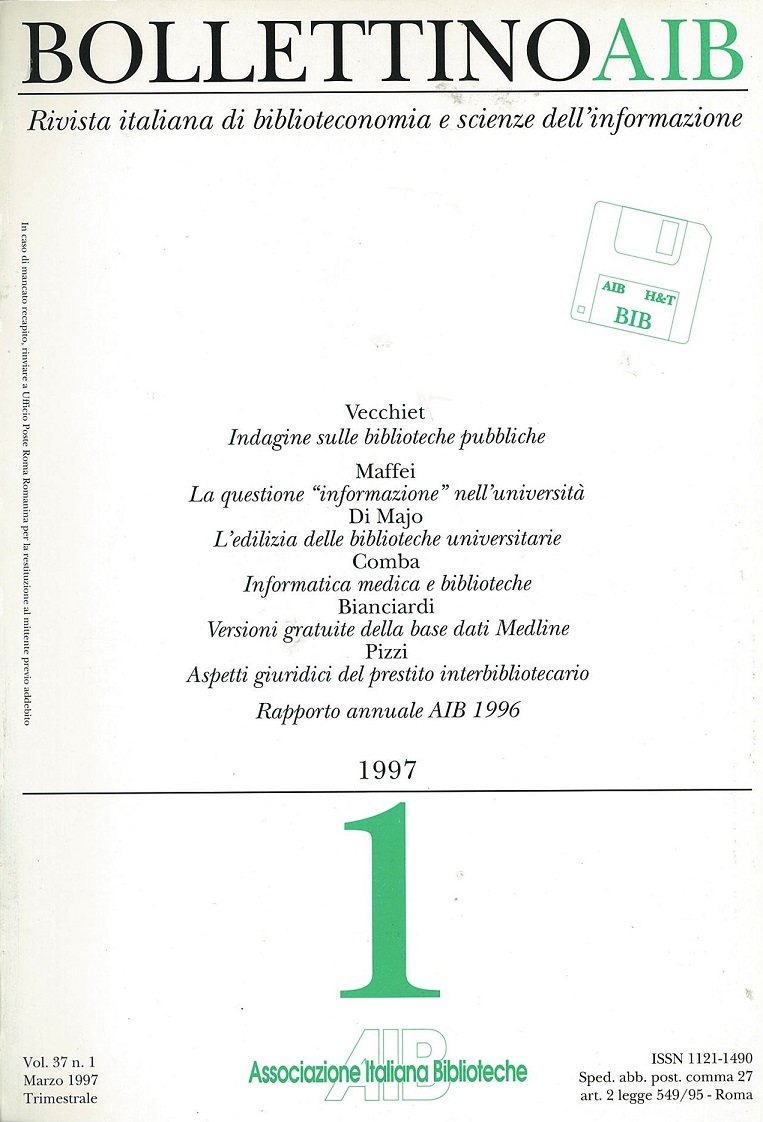A survey of perceptions of Italy's public library service
Main Article Content
Abstract
On 23-25 October 1996, the Trieste public opinion research institute SWG carried out the first national survey on how Italians perceive their public library service. The survey, commissioned by AIB, posed ten questions to a sample of one thousand respondents selected on the basis of three general levels of stratification (geographical area, town size and sex) which was subsequently standardised to ISTAT's data on age, educational level and occupation. The survey yielded some important assessments on the range of services provided by public libraries in Italy and also additional data on their use.
As regards use, 26.6% of respondents stated they use or used a public library "at least rarely" (with frequency varying from less than three to more than twenty-five times a year). Although this result was considered rather satisfactory when compared with previous surveys on Italians' reading habits, it was also deemed still modest as it merely confirms the substantially marginal position of the public library in Italians' social customs and cultural habits.
However, compared to a Eurisko survey of some twelve years earlier, one can cautiously hazard that the percentage of users has not only significantly increased vis-à-vis those who never set foot in a public library, but now boast a significant percentage of users who are not students and professors, or aged over 24, a sign of greater vitality and that the public library is gaining acceptance as a public service for all.
The subsample of frequent public library users gave a very positive evaluation as regards the quality of service which almost all the subsample (93%) felt was adequate. Librarians' cultural and professional standards, collections and opening hours were also judged satisfactory. The survey ended with two questions on the free provision of the public-library service (of which almost all the subsample approved) and on the willingness to finance, by a contribution proportional to income, a project to develop respondents' respective local public library. Most of the young and old (who were also the most generous in their evaluation of the service) were in favour of this proposal, while the 35-54 year olds, who tend to bear the brunt of fiscal pressure, tended towards caution or opposition.
There remain, however, significant differences between Northern and Southern Italy, not only as regards use, but also the evaluation of the service (with the surprising exception of users in Sardinia and Sicily). On a more positive note, alongside students and teachers, the "traditional" users of public libraries, other professions also often give a positive judgement. Although entrepreneurs and farmers continue not to use libraries, there are various professions which are now hesitantly starting to use public libraries, such as self-employed professionals, 15.4% of whom state they use the library often, while 39.7% define the service as good. It is a weak but significant sign that Italy's long closed and impermeable universe of public libraries is now attracting new users from outside its traditional user basin of the school and university, new users who are more attentive to those innovative services which the public library can offer.
ROMANO VECCHIET, Biblioteca civica "V. Joppi", piazza Marconi 8, 33100 Udine.Article Details

This work is licensed under a Creative Commons Attribution-ShareAlike 4.0 International License.
